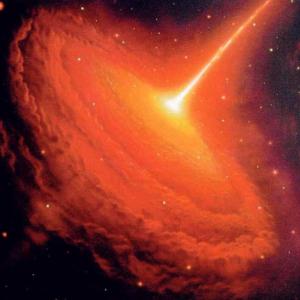College of Liberal Arts & Sciences
8C20.60 - Quasars
Telescope images of Quasars can be found on a variety of websites.
- Amos Harpaz, "More on Superluminal Velocities", TPT, Vol. 35, #1, Jan. 1997, p. 5.
- Amos Harpaz, "Superluminal Velocities in Astronomy?", TPT, Vol. 34, #8, Nov. 1996, p. 496.
- Denise C. Gabuzda, "The Use of Quasars in Teaching Introductory Special Relativity", AJP, Vol. 55, #3, Mar. 1987, p. 214.
- Kurtiss J. Gordon, "The Doppler Effect: A Consideration of Quasar Redshifts", AJP, Vol. 48, #7, July 1980, p. 514.
- T. Díaz-Santos, R. J. Assef, A. W. Blain, M. Aravena, D. Stern , C.-W. Tsai, P. Eisenhardt, J. Wu, H. D. Jun, K. Dibert, H. Inami, G. Lansbury, F. Leclercq, "The Multiple Merger Assembly of a Hyperluminous Obscured Quasar at Redshift 4.6", Science, Vol. 362, #6418, Nov. 2018, p. 1035.
- Maarten Schmidt and Francis Bello, "The Evolution of Quasars", Scientific American, Vol. 224, #5, May 1971, p. 54, and also in Scientific American Cosmology +1, "#6, The Evolution of Quasars", Sept. 1967, p. 43. See the Lecture Demo Reference Library in Rm. 58 for this reference.
- Dennis Sciama, "Review: Cosmology Before and After Quasars", Scientific American, Vol. 217, #3, Sep. 1967, p. 293, and also in Scientific American Cosmology +1, "#4, Cosmology Before and After Quasars", Sept. 1967, p. 31. See the Lecture Demo Reference Library in Rm. 58 for this reference.
- "Most Luminous Object", Guinness Book of World Records, 2003, p. 71.
- Physics History, "February 5, 1963: Maarten Schmidt Discovers First Known Quasar", APS News, Vol. 30, #2, Feb. 2021, p. 2.
Disclaimer: These demonstrations are provided only for illustrative use by persons affiliated with The University of Iowa and only under the direction of a trained instructor or physicist. The University of Iowa is not responsible for demonstrations performed by those using their own equipment or who choose to use this reference material for their own purpose. The demonstrations included here are within the public domain and can be found in materials contained in libraries, bookstores, and through electronic sources. Performing all or any portion of any of these demonstrations, with or without revisions not depicted here entails inherent risks. These risks include, without limitation, bodily injury (and possibly death), including risks to health that may be temporary or permanent and that may exacerbate a pre-existing medical condition; and property loss or damage. Anyone performing any part of these demonstrations, even with revisions, knowingly and voluntarily assumes all risks associated with them.
